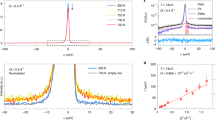Abstract
The experimental and theoretical studies of the structure of conduction channels of superionic conductors are analyzed. A crystallochemical method of modeling the conduction channels is proposed in which they are treated as sets of polyhedron Vorono-Dirichlet sections outside of impenetrable spheres of the rigid sublattice. The allowance for both weak flexibility of the spheres and their mean-square displacements relative to the sublattice points yields a channel structure that “wraps” around the Vorono-Dirichlet polyhedron edges. Modeling the interionic potential for α-AgI with the help of equipotential surfaces suggests that the mobile-ion motion slips along the conduction channel walls. For α-AgI, the set of the equipotential surfaces specifies “the minimum energy trajectory” of transition into a superionic state, while the crystallochemical “wrapping” structure corresponds to a saddle point of a multidimensional potential surface. Symmetry selection rules are used for predicting mechanical trajectories as allowed oscillation modes for the tetrahedral and octahedral fragments of α-CuI.
Similar content being viewed by others
References
J. B. Boys and T. M. Hayes, in Physics of Superionic Conductors, Ed. by M. B. Salamon (Springer-Verlag, Berlin, 1979; Zinatne, Riga, 1982).
S. M. Shapiro and F. Reidinger, in Physics of Superionic Conductors, Ed. by M. B. Salamon (Springer-Verlag, Berlin, 1979; Zinatne, Riga, 1982).
H. U. Beyeler, P. Brüesch, L. Pietronero, et al., in Physics of Superionic Conductors, Ed. by M. B. Salamon (Springer-Verlag, Berlin, 1979; Zinatne, Riga, 1982).
T. Geisel, in Physics of Superionic Conductors, Ed. by M. B. Salamon (Springer-Verlag, Berlin, 1979; Zinatne, Riga, 1982).
V. I. Polyakov, Zh. Fiz. Khim. 71(7), 1248 (1997); 72 (11), 2002 (1998); 72 (12), 2247 (1998).
L. W. Strock, Z. Phys. Chem., Abt. B 25, 441 (1934); 31, 132 (1936).
W. Bührer and W. Hälg, Helv. Phys. Acta 47, 27 (1974).
R. J. Cava, F. Reidinger, and B. J. Wuensch, Solid State Commun. 24, 411 (1977).
H. G. Schnering and R. Nesper, Angew. Chem. Int. Ed. Engl. 26, 1059 (1987).
J. B. Boyce, T. M. Hayes, J. C. Mikkelsen, et al., Solid State Commun. 33, 183 (1980).
W. Bührer and W. Hälg, Electrochim. Acta 22, 701 (1977).
Y. Kaneko, A. Ueda, and Y. Hiwatari, J. Phys. Soc. Jpn. 55(4), 1244 (1986).
G. Dalba, P. Fornasini, R. Gotter, et al., Philos. Mag. B 71(4), 751 (1995).
V. I. Polyakov, Zh. Fiz. Khim. 73(9), 1601 (1999).
S. Glasstone, K. J. Laidler, and H. Eyring, Theory of Rate Processes (McGraw-Hill, New York, 1941; Inostrannaya Literatura, Moscow, 1948).
R. Bachmann and H. Schulz, Solid State Ionics 9/10, 521 (1983).
R. Pearson, Symmetry Rules for Chemical Reactions (Academic, New York, 1976; Mir, Moscow, 1979).
Author information
Authors and Affiliations
Additional information
__________
Translated from Kristallografiya, Vol. 46, No. 3, 2001, pp. 485–493.
Original Russian Text Copyright © 2001 by Polyakov.
Rights and permissions
About this article
Cite this article
Polyakov, V.I. Structure of conduction channels in superionic conductors: Crystallochemical modeling. Crystallogr. Rep. 46, 435–443 (2001). https://doi.org/10.1134/1.1376474
Received:
Accepted:
Issue Date:
DOI: https://doi.org/10.1134/1.1376474



